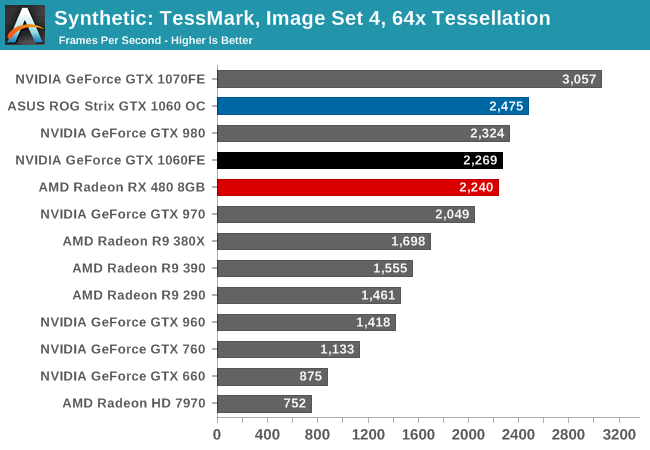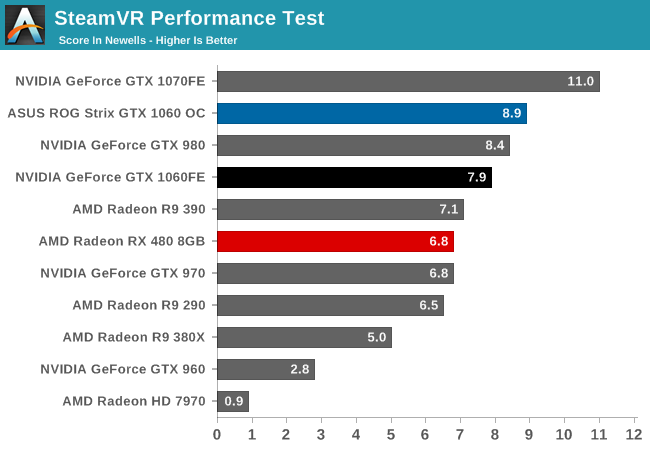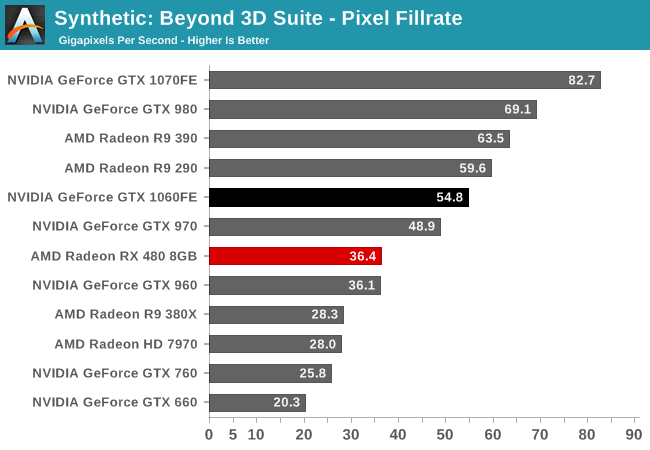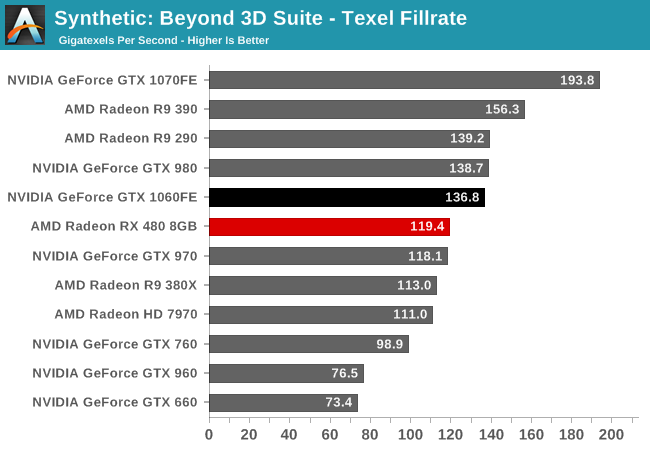The GeForce GTX 1060 Founders Edition & ASUS Strix GTX 1060 Review
by Ryan Smith on August 5, 2016 2:00 PM ESTSynthetics
As always we’ll also take a quick look at synthetic performance. While GTX 1060 is of course a cut down Pascal architecture part, how it has been cut down is interesting. Compared to GP104, GP106 has half the SMs and GPCs, but 3/4 the ROPs, which may prove to have an impact.

Starting off with tessellation performance, we find the GTX 1060 coming in just behind the GTX 980, showing that NVIDIA’s performance estimates generally apply not only to games, but synthetic tests as well. But perhaps more interesting is the fact that the card is neck-and-neck with the Radeon RX 480. NVIDIA has traditionally enjoyed a sizable geometry performance lead over AMD cards, but it looks like those days have come to a close.
Up next, we have SteamVR’s Performance Test. While this test is based on the latest version of Valve’s Source engine, the test itself is purely synthetic, designed to test the suitability of systems for VR, making it our sole VR-focused test at this time. It should be noted that the results in this test are not linear, and furthermore the score is capped at 11. Of particular note, cards that fail to reach GTX 970/R9 290 levels fall off of a cliff rather quickly. So test results should be interpreted a little differently.

As NVIDIA’s now entry-level VR card, GTX 1060 looks very good in the Steam VR test. A score of 7.9 Newells means that it’s comfortably above the 6.x range generally required, and it also means the GTX 1060 is comfortably ahead of the RX 480 in this scenario.
Finally, for looking at texel and pixel fillrate, we have the Beyond3D Test Suite. This test offers a slew of additional tests – many of which use behind the scenes or in our earlier architectural analysis – but for now we’ll stick to simple pixel and texel fillrates.

Starting with the pixel fillrate, we can see the impact of GTX 1060’s slightly more unusual ROP and GPC arrangement when it’s compared to the GTX 980. At 54.8 GPixels/second, GTX 1060 trails GTX 980 significantly. The card not only has fewer ROPs, but it has half of the rasterizer throughput (32 pixels/clock) as GTX 980. As we’ve seen in our gaming benchmarks the real-world impact isn’t nearly as great as what happens under these synthetic tests, but it helps to explain why sometimes GTX 1060 is tied with GTX 980, and other times it’s several percent behind. If nothing else, at an architectural level this is what makes GTX 1060 a better 1080p card than a 1440p card.

As for texel throughput, things are right where we expect them. GTX 1060 is virtually tied with GTX 980, and while it’s ahead of RX 480 in the process, it’s not by a massive amount.










189 Comments
View All Comments
Ryan Smith - Friday, August 5, 2016 - link
Since there is no standard benchmark, it depends on the area you use. We purposely picked a section of the game that would be among the most demanding.Arbie - Friday, August 5, 2016 - link
I really want to 'need' a new graphics board for FPS gaming. But I can't find any such games worth playing that need one. They're all console ports with mediocre graphics and even worse mechanics. And my GTX 770 is more than enough even on 2560x1440. I still read about the new cards but... how long...Simplex - Sunday, August 7, 2016 - link
"And my GTX 770 is more than enough even on 2560x1440"So you play at sub-30 fps and/or low details?
Arbie - Sunday, August 7, 2016 - link
Simplex - Can't see how you jumped to that conclusion, so I guess you're just trying to be contentious. FOR THE GAMES I *DO* PLAY the 770 is fine. That's my point, and the reason I personally am not in the market.I don't check frames per sec unless the gameplay is laggy. When it is - which is rare with the 770 - I dial down the eye-candy. Beyond a certain point that doesn't matter anyway, compared to game design & mechanics. The problem is that there are NO NEW FPS GAMES that deliver on those two aspects. My benchmark game is Crysis (and its siblings) which I run at "Very High" settings. There are a few games now with equally good graphics, but nothing even compares for fluidity, control, physics, level design, AI quality etc etc. Until there is, I won't need a new card. I wish it were otherwise.
just4U - Friday, August 5, 2016 - link
A note for Nvidia since they will likely read these comments (..as will AMD)I've said there is a market for a reference design using a stylish reference cooler (like what you see on the Titan series..) For some it's worth the $50 admission. If your going to do that at the lower end but charge a premium... make sure it's got the same goodness as the upper end models.
Your 1060 Founders might sell.. but it won't sell as well as it could have if you'd gone all out on the cooler like you have for the higher end models. Plastic? Ugh.. No full backplate? Please.. Come on!
AnnonymousCoward - Friday, August 5, 2016 - link
Now that you mention it, I've got a note for NVIDIA too: support the VESA standard Adaptive-Sync already! My monitor supports it, why won't you.Gigaplex - Monday, August 8, 2016 - link
If they do that, then there would be no reason for manufacturers to produce G-SYNC monitors. They'd all flock to Freesync compliance.Beararam - Friday, August 5, 2016 - link
Great review, Ryan. Hope all the negative comments don't bring you down. Probably a lot going on behind the scenes that we don't see.VulkanMan - Friday, August 5, 2016 - link
Why no encoding tests?Both camps support H.265 HEVC encoding & decoding.
Ryan Smith - Saturday, August 6, 2016 - link
I've looked into it, but I haven't found any good encoding tests right now, particularly those that use HEVC. But if you happen to come across something, then I'm all ears.=)